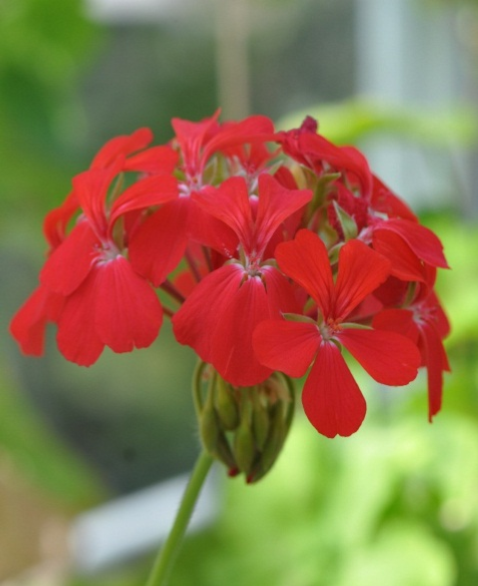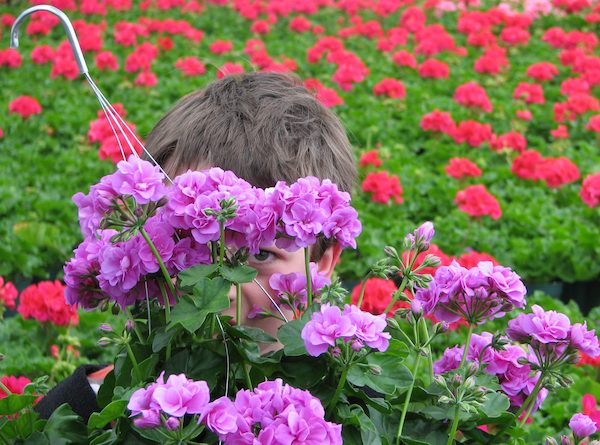
Geraniums, with their cheerful faces and nonstop flowering power, are a favorite among gardeners. These sun-worshipping beauties bring bursts of color to balconies, patios, and flower beds, demanding little in return for their dazzling displays. But where do you begin? This comprehensive guide will unveil the secrets to planting, growing, and caring for geraniums, transforming you from a novice to a geranium guru in no time.
Unveiling the Geranium: A World of Varieties
Before diving headfirst into the world of geraniums, it’s important to understand the fascinating diversity within this floral family. Did you know there are over 400 species of geraniums, each boasting unique characteristics? Here’s a glimpse into the two most common types you’ll encounter:
Zonal Geraniums

These are the classic geraniums, often sporting vibrant red blooms and horseshoe-shaped markings on their leaves. They’re renowned for their compact, bushy growth habit, making them ideal for container gardening.
Ivy Geraniums

Cascading stems adorned with delicate, single or double flowers define ivy geraniums. Their trailing nature makes them perfect for hanging baskets or window boxes, where their delicate vines can gracefully drape down.
Beyond these two main types, fragrant geraniums, with their rose- or lemon-scented foliage, and Martha Washington geraniums, known for their large, showy blooms, offer even more variety to explore.
Planting Power: Setting the Stage for Success
Now that you’re acquainted with the geranium family, let’s get your hands dirty! Here’s how to set your geraniums up for thriving success:
Choosing the Right Spot: Geraniums are sun-worshippers. Aim for a location that receives at least 6-8 hours of direct sunlight daily. Morning sun is particularly beneficial, as it helps dry morning dew and prevents fungal diseases.
Potting Powerhouses: If you’re opting for container gardening, select pots with drainage holes to prevent waterlogging. Opt for a pot size that allows for about 1-2 inches of space around the root ball of your geranium plant.
Soil Sensations: Geraniums favor well-draining, fertile soil. A good quality potting mix specifically formulated for flowering plants is ideal. You can also create your own mix by combining potting soil, perlite, and compost in a ratio of 2:1:1.
Planting Perfection: Gently remove your geranium plant from its container and loosen the roots slightly. Dig a hole in your chosen pot or garden bed slightly larger than the root ball. Place the plant in the hole and fill the surrounding space with soil, ensuring the base of the stem sits slightly above the soil level. Water the plant thoroughly to settle the soil.
Nurturing Your Geraniums: A Recipe for Vibrant Blooms
With your geraniums planted, it’s time to focus on care to witness their true potential. Here are some key aspects to remember:
Watering Wisdom: Geraniums are surprisingly drought-tolerant once established. The key is to water deeply when the top inch of soil feels dry to the touch. Avoid overwatering, as this can lead to root rot.
Feeding Frenzy: During the active growing season (spring and summer), fertilize your geraniums every two weeks with a balanced liquid fertilizer diluted according to the package instructions. Opt for a fertilizer formulated for flowering plants to encourage abundant blooms.
Pruning Prowess: Regular pruning is a geranium’s best friend. It promotes bushier growth, prevents legginess, and encourages more flowering. Pinch back the growing tips of stems throughout the season to achieve a compact and floriferous plant.
Deadheading Delights: To extend the blooming period of your geraniums, deadhead spent flowers regularly. Simply pinch or snip off the wilted flower head just below the base, encouraging the plant to produce new blooms instead of focusing on seed production.
Overcoming Obstacles: A Geranium Guardian’s Guide
While geraniums are generally low-maintenance, there can be occasional challenges. Here’s how to identify and address some common issues:
Yellowing Leaves: This could be a sign of overwatering, nutrient deficiency, or even sunburn. Ensure proper drainage, adjust your watering habits, and fertilize if necessary. If the leaves are scorched, move the plant to a location with some afternoon shade.
Bud Rot: This fungal disease thrives in humid conditions. Remove affected flowers and improve air circulation around your plants. In severe cases, a fungicide may be necessary.
Whiteflies: These tiny, sap-sucking insects can weaken your geraniums. Regular monitoring and insecticidal soap sprays can keep them at bay.
Geraniums in Winter: Embracing Dormancy or Indoor Adventures?
As summer wanes and cooler temperatures settle in, you might wonder about the fate of your beloved geraniums. Here, we explore two approaches to caring for your geraniums during the winter months:
Embracing Dormancy: A Natural Rest
In regions with mild winters where temperatures rarely dip below freezing, geraniums can enter a period of dormancy outdoors. Here’s how to prepare them for a restful winter:
- Reduce Watering: Gradually decrease watering frequency as the days shorten and temperatures cool. Aim to keep the soil barely moist.
- Deadheading and Pruning: Once the first frost arrives, remove any remaining flowers and dead foliage. Prune the stems back by about one-third to promote healthy new growth in spring.
- Winter Mulch: Apply a layer of mulch (such as shredded bark or compost) around the base of the plant to insulate the roots and protect them from freezing temperatures.
Waking Up in Spring: Once the threat of frost has passed and spring arrives, remove the winter mulch and gradually increase watering as new growth emerges. You can also fertilize lightly to kickstart the growing season.
Indoor Adventures: Bringing the Blooms Inside
If your area experiences harsh winters, consider bringing your geraniums indoors to enjoy their vibrant blooms throughout the colder months. Here’s how to make the transition smooth:
- Choosing Candidates: Select healthy geranium plants with plenty of remaining foliage. Avoid those with signs of disease or pest infestation.
- Light Up Their Lives: Indoor geraniums need plenty of bright, indirect sunlight. A south-facing window is ideal. If sunlight is limited, consider supplementing with grow lights.
- Temperature Talk: Aim for a comfortable indoor temperature range between 65-70°F (18-21°C) for optimal growth. Avoid placing your geraniums near drafts or heating vents.
- Watering Wisely: Indoor geraniums generally require less water than outdoors. Water only when the top inch of soil feels dry to the touch.
Springtime Transition: Once spring arrives and outdoor temperatures consistently stay above 50°F (10°C), you can gradually harden off your geraniums and reintroduce them to the outdoors.
Geraniums: Beyond the Bloom – Propagation Power
The joy of geraniums doesn’t have to end with a single plant. With a little know-how, you can propagate your geraniums and create an army of flowering beauties. Here are two popular methods:
Stem Cuttings:
- Select healthy, non-flowering stems with at least a few nodes (leaf junctions).
- Cut the stem just below a node at a 45-degree angle.
- Remove the lower leaves, leaving a few nodes exposed.
- Dip the cut end of the stem in rooting hormone (optional but can improve success rates).
- Plant the stem cutting in a pot filled with moist potting mix. Water lightly and keep the soil consistently moist but not soggy.
- Place the pot in a warm, well-lit location (indirect sunlight).
- New roots should develop within a few weeks. Once established, you can pinch back the top of the cutting to encourage bushier growth.
Seed Sowing:
- While less common, geraniums can be grown from seeds. However, be aware that seedlings may not always retain the exact characteristics of the parent plant.
- Sow seeds indoors in a well-draining potting mix around 8-10 weeks before the last frost date in your area.
- Lightly cover the seeds with soil and keep the surface moist.
- Place the pot in a warm location with good light. Germination can take several weeks.
- Once seedlings emerge and develop a few sets of true leaves, you can transplant them into individual pots.
With a little TLC and these handy tips, your geraniums will not only thrive throughout the season but also provide you with opportunities to expand your floral collection. So, get planting, nurturing, and propagating – and enjoy the vibrant rewards that geraniums have to offer!
